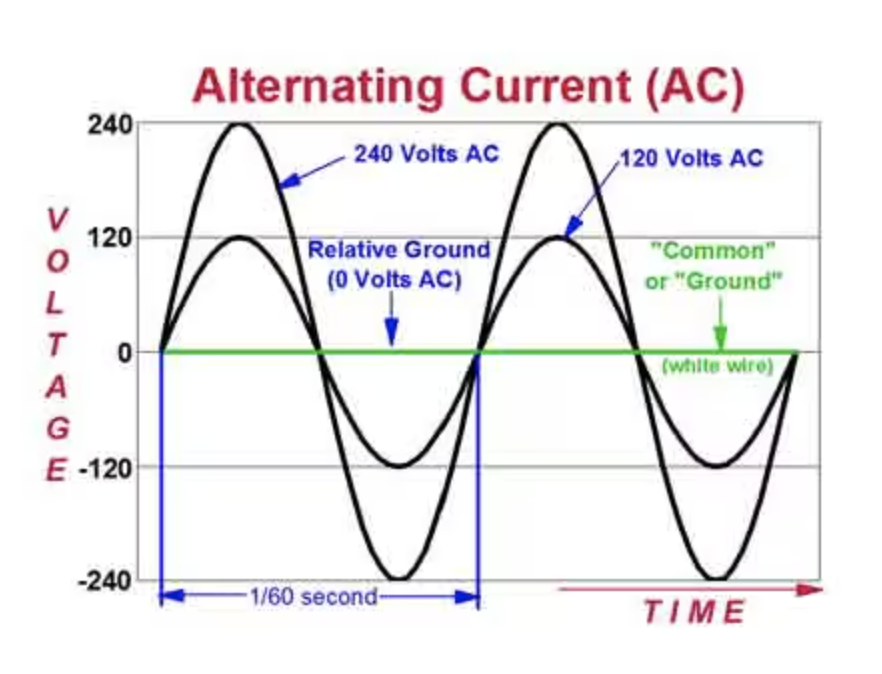What Is Alternating Current
What is Alternating Current?
Alternating current is a fundamental aspect of electrical systems that have shaped our world in countless ways. Its ability to be easily generated, converted to different voltages, and transmitted over long distances has made it the preferred choice for power transmission and distribution. Additionally, the many advantages of AC, such as compatibility with various devices and safety features, have made it indispensable in our daily lives.

In the world of electricity, there are two primary forms of electric current: alternating current (AC) and direct current (DC). Understanding the distinctions between these two types of currents and their applications in daily life is essential to appreciate the advances in electrical engineering and the technology that surrounds us.
Alternating current (AC) and direct current (DC) are two distinct ways electric charge is transferred through a circuit. AC involves the flow of charge that periodically reverses direction, creating a waveform typically resembling a sine wave. On the other hand, DC refers to the flow of charge in a single, constant direction. The differences in their nature, functionality, and applications create a contrasting landscape in electrical power.
One key reason why AC is preferred over DC is its ability to easily convert to and from high voltages, making electric power transmission across long distances more efficient. In addition, transformers can increase AC voltage or decrease it, resulting in minimal power loss during long-distance transmission. In contrast, DC power cannot be altered as conveniently, making it less suitable for power transmission over extended distances.
The working principle of AC is centred around the changing magnetic field created by the flow of electric current. As the current changes direction, the magnetic field also alternates, inducing a voltage in the nearby conductors. This property of AC is fundamental to operating AC generators and transformers.
The invention of AC can be attributed to multiple individuals, but the Serbian-American inventor, Nikola Tesla, is often credited with pioneering AC systems. Tesla's work on AC power transmission and his development of the induction motor helped establish AC as the dominant form of electricity.
In frequency, the terms 50-cycle and 60-cycle alternating current refers to the number of times the current changes direction in one second. The frequency of AC power varies across the globe, with 50 Hz being the standard in many parts of Europe, Asia, and Africa, while 60 Hz is the norm in North America. This difference in frequency can affect the operation of certain appliances and devices, making it essential to use the appropriate frequency for the intended purpose.
The advantages of AC over DC extend beyond efficient power transmission. AC is easier to generate and is widely used for electric power generation, making it more accessible and cost-effective. Moreover, AC systems are safer as they can be easily switched off when required, reducing the risk of electrical accidents. AC is versatile and can power various devices, from small household appliances to large industrial machines.
The generation and transmission of AC are crucial components of the electrical power infrastructure. AC is generated through various means, such as hydroelectric, thermal, and nuclear power plants, which use generators to convert mechanical energy into electrical energy. Once generated, AC is transmitted through power lines consisting of transformers, transmission towers, and substations that adjust the voltage levels for efficient distribution and usage.
The alternating current plays a vital role in our daily lives, as it powers most of the appliances and devices we rely on, including lights, computers, and household appliances. In addition, its compatibility with transformers, ease of generation, and ability to transmit power over long distances make it a cornerstone of modern electrical systems.
Frequency has a notable impact on AC usage. In addition to determining the compatibility of devices with a region's power supply, the frequency of AC power affects electrical motors' speed and performance. A change in frequency may result in the motor operating at a different speed or, in some cases, malfunctioning.
Transformers are essential devices in AC systems, as they adjust voltage levels to meet the requirements of various applications. They function by utilizing the principle of electromagnetic induction, with the changing magnetic field in the primary coil inducing a voltage in the secondary coil. By altering the number of turns in the coils, transformers can efficiently increase or decrease the voltage of AC power, depending on the application's specific needs.
The differences between alternating current and direct current are crucial in understanding the diverse landscape of electrical power. The invention of AC by Nikola Tesla and other inventors has revolutionized how we generate, transmit, and use electricity. With an appreciation for the characteristics and applications of alternating current, we can better understand the technology and infrastructure that powers our world.
How Does Alternating Current Work?
Alternating current (AC) works by periodically changing the direction of the flow of electric charge within a circuit. In contrast to direct current (DC), which flows in a constant direction, AC oscillates back and forth. This oscillation is typically represented as a waveform, often in the shape of a sine wave. Let's dive deeper into how alternating current works.
Generation: AC is generated using a rotating magnetic field to induce an electric current in a conductor. This is done using devices such as generators and alternators, which convert mechanical energy into electrical energy. In these devices, a coil of wire rotates within a magnetic field, or a magnet rotates around a stationary coil. This rotation causes the magnetic field to interact with the conductor, inducing a voltage and, consequently, an electric current that changes direction periodically.
Waveform: The alternating nature of AC is depicted by a waveform, which shows the voltage or current as a function of time. The most common waveform for AC is the sine wave, which can also take other forms, such as square or triangular waves. The waveform's shape determines the characteristics of the AC and how it interacts with various electrical components.
Frequency: One important parameter of AC is its frequency, which indicates the number of complete cycles the current undergoes per second. It is measured in hertz (Hz). Common frequencies include 50 Hz and 60 Hz, but other frequencies can also be used depending on the application. The frequency of the AC affects the performance and compatibility of devices and equipment connected to the power supply.
Voltage and current relationship: In an AC circuit, the voltage and current can be in phase (i.e., they reach their peak values simultaneously) or out of phase (i.e., they reach their peak values at different times). The phase relationship between voltage and current in an AC circuit can significantly impact the power delivery and the system's efficiency.
Transformers: A key advantage of AC is that its voltage can be easily changed using transformers. Transformers work on the principle of electromagnetic induction, with a changing magnetic field in the primary coil inducing a voltage in the secondary coil. By adjusting the number of turns in the coils, the transformer can step up or down the AC voltage as needed. This ability to adjust voltage levels makes AC suitable for efficient long-distance power transmission.
What is the formula to calculate alternating current?
To calculate the value of alternating current (AC) at any given time, you need to know the current's amplitude (maximum value) and the angular frequency. The general formula for calculating instantaneous current in an AC circuit is:
i(t) = I_max * sin(ωt + φ)
Where:
i(t) is the instantaneous current at time t
I_max is the amplitude or peak current
ω (omega) is the angular frequency, calculated as 2πf (where f is the frequency in hertz)
t is the time at which you want to calculate the current
φ (phi) is the phase angle, which accounts for any phase shift between the voltage and the current waveforms
Remember that this formula assumes a sinusoidal waveform, the most common form of AC. If the waveform is not sinusoidal, the formula will be different and depend on the specific shape of the waveform.
Another important value for AC circuits is the root-mean-square (RMS) current, which measures the effective current. The RMS current is useful for calculating power in AC circuits and can be compared to the steady current value in DC circuits. The formula to calculate RMS current from the peak current is as follows:
I_RMS = I_max / √2
Where:
I_RMS is the root-mean-square current
I_max is the amplitude or peak current
√2 is the square root of 2, approximately 1.414
Using these formulas, you can calculate the instantaneous current value for an alternating current waveform and determine the effective or RMS current value.
Electrical Operations provides detailed insights into safe and efficient electrical procedures, guiding practitioners through every step of handling electrical systems.













